Page 745 - Hand rearing birds second
P. 745
House Finches, Goldfinches, and House Sparrows 747
Increase biosecurity and separate sickly chicks from healthy chicks, and affected cages from
healthy birds. Treat all affected and exposed chicks. Subcutaneous fluids may be needed for chicks
with delayed crop emptying. Consult an avian veterinarian for diagnostic tests and further
treatment.
Diets
Hand-feeding
Unusually among passerines, House Finch chicks are not fed a primarily insect diet during the
early stages of life. The parents regurgitate a mixture of seeds, other plant material, and about 2%
insect protein for the developing chicks. Thus, the most common passerine insect‐based or insect‐
replacement diets are not ideal for these birds. Commercial diets for raising parrots are also prob-
lematic, yielding feathering of generally poor quality, likely due to parrot chicks’ relatively low
requirement for protein.
®
A mix of Kaytee exact Hand Feeding Formula (Kaytee) and a high protein neonate formula such
®
as Emeraid IC Carnivore (Lafeber Company) will produce healthy House Finch fledglings with
quality feathering, who reach maturity on roughly the same schedule as birds raised in the wild by
their parents. Another benefit of the inclusion of Exact may be that it contains beneficial bacteria
and digestive enzymes.
Mixing Kaytee exact and Emeraid Carnivore at a 50/50 ratio can be used for all ages, from hatch-
lings to weanlings. Mix the two diets as powder, then add water until a smooth, “cake‐batter”
consistency is achieved – this is usually at 2 : 1 ratio (water : powder). Some caregivers have started
hatchlings on straight higher protein Emeraid IC Carnivore, then transitioned to straight Kaytee
exact for weanlings with a gradation in between. However, this can prove difficult in high volume
shelters and the end results – a healthy, independent, juvenile finch raised in a timely manner – is
equally achievable with the 50/50 formulation. Goldfinches can also be raised on this formula, as
the primary diet fed to chicks of these species is also regurgitated seeds.
House Sparrow chicks have a more normal passerine wild diet and can do well on any of the
blended diets listed in Table 41.3, or when treated as insectivores (see Chapter 43). The author
(GP) has had excellent results using Basic Nestling Diet (see Table 41.3) when rearing this
species.
Self-Feeding
Once birds are leaving the nest and starting to explore, a diverse mix of small seeds should be
offered. “Canary Mix” or “Finch mix” or similar undyed mixes work well, especially if other
seeds such as niger (thistle) are mixed in for variety. Goldfinches are particularly attracted to
thistle seeds and millet spray. Fresh plant material such as broccoli florets, parsley sprigs, minced
greens, and halved grapes are popular first foods. House Sparrows may also eat small insects and
crumbled hard‐boiled egg. Other possible foods include fennel, crushed nuts, currants, minced
apple or cherries, and ground kitten kibble. Present food as an array of easily visible items.
Shallow lids make excellent seed dishes, although scatter some seed on the floor as well. Broccoli
florets and halved sideways grapes may be impaled on a bamboo skewer as “shish kabobs” and
suspended within easy reach of perches. Another presentation option is to drill a hole in one side
of the long arm of a wooden clothespin big enough to snugly fit a short bamboo skewer segment.
Fill the skewer with fresh fruits and vegetable chunks, wedge one end in the clothespin, and

